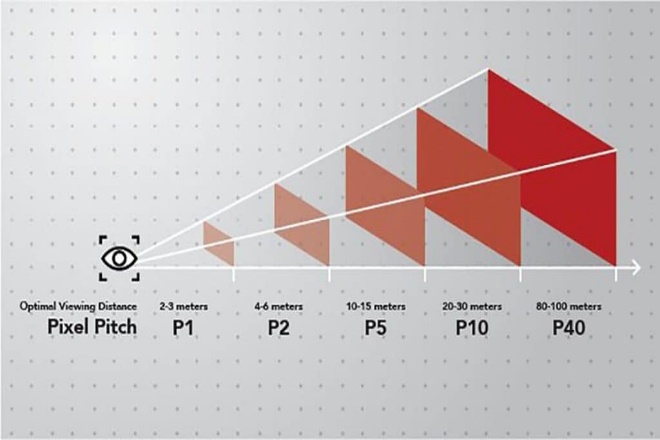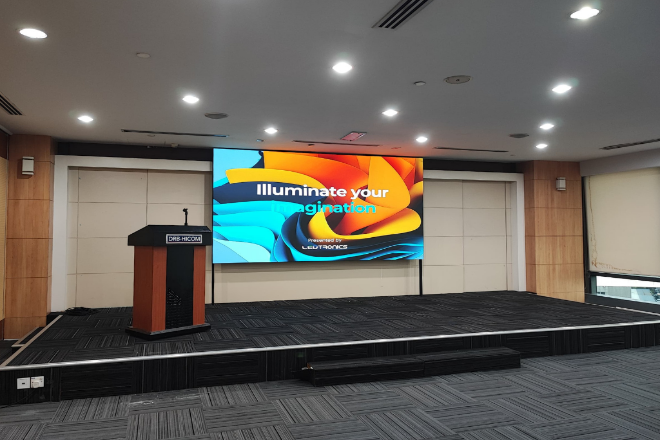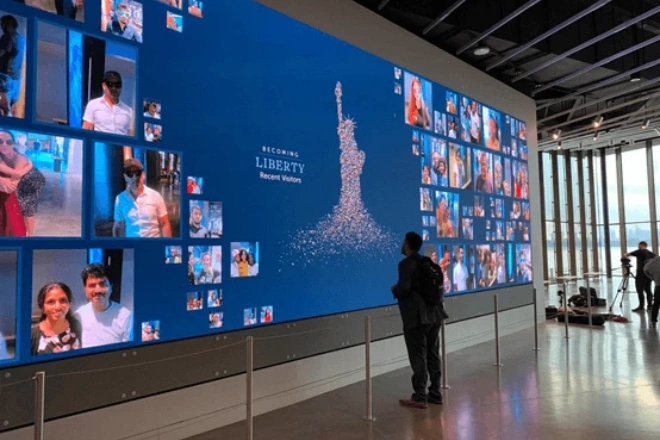序章

The installation of LEDディスプレイ is also a very important part. When installing, everyone likes to emphasize the best viewing distance. So, what is the best viewing distance? How do you calculate the best viewing distance for an LED display?
This article will introduce how to scientifically calculate the best viewing distance of LED displays and explore its influencing factors to help you get the best visual experience in various scenarios.
1. What is the best viewing distance for viewing an LED display?
LED displays are a “visual responsibility” in modern life. Whether it is a bustling commercial street, a high-end conference room, etc., it can be seen. But do you know? When watching LED screens, distance is a big question!
Too close, the eyes can’t stand it, and you may not be able to see the overall picture; too far, the details can’t be seen clearly, affecting the viewing experience. So, what is the best 視聴距離 for viewing an LED display?
In fact, the best viewing distance is not a fixed value. Simply put, it is the distance that makes your eyes comfortable and allows you to see the screen content clearly.
2. What is the method to calculate the best viewing distance of an LED display?

1). 基本式
First, you must have a basic formula as a reference, which is:
Optimal viewing distance = resolution factor × dot pitch
The “dot pitch” here is the distance between the small dots on the screen, such as P2.5 is 2.5 mm. The “resolution factor” is an adjustable number, generally between 1000 and 3000. If you want to see more clearly, adjust the factor to a smaller value。
If you want to see farther, adjust it to a larger value. For example, if you have a P2.5 screen and want to see more details, choose a resolution factor of 2000, then the optimal viewing distance is 2.5 mm × 2000 = 5 meters.
2). Different occasions, different distances
However, the formula is dead, and people are alive. Different occasions have different requirements for viewing distance.
- Control room:
Here, we have to keep an eye on every detail, so the screen has to be closer, and the resolution factor is selected to be smaller, such as 2000. For a P1.5 screen, the optimal viewing distance is about 3 meters.
- Meeting room:
Everyone should be able to see clearly here, but not too close to hurt the eyes. The P3 screen has a resolution factor of 2500, so about 7.5 meters is quite suitable.
- 屋外看板:
You have to watch from a distance. The P10 screen has a resolution factor of 3000 and can be seen from 30 meters away.
3). Do you know these tips?
In addition to the basic formula, there are some tips that can help you find the best viewing distance.
- RGB color mixing distance:
Want to know when the three colors can be mixed together, and the boundaries can’t be seen? Then multiply the pixel pitch by 500, and the distance you get is it. For example, for a P2.5 screen, it is 1.25 meters.
- Minimum clear distance:
To ensure that the image does not look blurry, how far away from the screen should you be at least? Multiply the pixel pitch by 1000. For a P2.5 screen, it is 2.5 meters.
- Farthest viewing distance:
In theory, how far away from the screen can you still see it? Multiply the height of the screen by 30, which is about this number. However, if you look at it from such a distance, the details will be gone.
4). To sum up, find your “just right.”
After all the calculations, it is actually to find a distance that makes your eyes comfortable and can see the screen content clearly. Remember, the formula is just a reference. It depends on your own needs and the environment in which you use it.
Whether it is a rigorous discussion in a conference room or a dazzling outdoor billboard, only by finding the “just right” distance can the LED display screen bring out its greatest charm. Next time you look at an LED screen, don’t forget to calculate the best viewing distance!
3. What are the factors that affect the best viewing distance?
When it comes to the best viewing distance of LED displays, you can’t just stand anywhere! It is actually affected by many factors. Let’s talk about it together!
1). Screen size and 解決:
This is the big deal! The larger the screen size, the larger the picture will naturally be. It doesn’t matter if you stand closer to watch it, your eyes won’t be too tired. Moreover, the higher the resolution, the more delicate the picture.
Just like when we watch high-definition movies, we are not afraid of blurring when we watch them up close. So, with a large screen and high resolution, the best viewing distance can be appropriately closer.
2). Viewing content:
Even though they are all LED screens, the viewing distance should be different for different contents. For example, if you play a high-definition video, the picture will move around, and there will be a lot of details, so you have to stand closer to see it clearly. But if you show text or static pictures, it is not so demanding, and it is okay to stand farther away.
3). Viewer’s personal preferences and vision:
This varies from person to person! Some people have good eyesight and can see clearly, so they like to stand closer to watch and feel that it is more exciting.
Some people have poor eyesight, or they like to watch from a distance and feel that it is more comfortable. So, the best viewing distance depends on your own preferences and vision.
4). Ambient light conditions:
Don’t underestimate this factor! If you watch an LED screen in a strong light environment, such as outdoors in broad daylight, the light on the screen will have to “fight” with the sunlight. At this time, if you stand too close, you may feel that the screen is too bright and your eyes can’t stand it.
If you stand too far away, you may not be able to see clearly. So, in a strong light environment, you may have to increase the viewing distance appropriately to maintain a good visual effect.
4. Adjustment and optimization methods in practical applications

1). The on-site situation must be understood, and the distance adjustment must be flexible:
Each place where LED display screens are used is different; some are dark, some are bright, some viewers are close, and some are far away. So, we can’t just follow the formula; we have to adjust the viewing distance according to the actual situation.
For example, in a place with strong sunlight outdoors, you may have to let the audience stand farther away and turn up the screen brightness so that they can see the content clearly. In an indoor conference room, the audience may be very close to the screen, so you have to choose a screen with a small dot pitch to make the picture more delicate.
2). The viewing effect will be better if the dot pitch is well selected:
The dot pitch, to put it bluntly, is the distance between the small dots on the screen. This dot pitch is closely related to the viewing distance. Think about it: if the audience is very close to the screen, but the dot pitch is large, then they can only see large pixel blocks one by one.
So, we have to choose the dot pitch according to the viewing distance. For close viewing, choose a small dot pitch; for long-distance viewing, choose a large dot pitch. In this way, the picture can be both clear and beautiful.
3). Design optimization is essential for a better viewing experience:
In addition to adjusting the viewing distance and selecting the dot pitch, we can also improve the viewing experience by optimizing the design. For example, we can adjust the brightness, contrast, and color saturation of the screen to make the picture look more comfortable.
We can also consider the installation angle and height of the screen to ensure that the audience can see the content from the best viewing angle. We can even add an anti-glare layer to the screen to reduce reflection and glare, making the audience’s eyes more comfortable.
4). Audience needs and environmental factors, none of which can be missing:
When using LED display screens, we have to consider the audience’s needs and environmental factors. For example, in a conference room, the audience may need to see every word on the PPT clearly, so we have to choose a high-resolution screen so that the audience can watch it from a closer distance.
On outdoor billboards, the audience may be far away, so we have to choose a larger screen and brighter lights to ensure that they can see clearly from a distance. In addition, ambient light is also an important factor. If the light is too strong, we may have to adjust the brightness of the screen or add a sunshade to reduce reflections.
5). Intelligent adjustment and personalized customization make the LED display screen “understand” you better:
Nowadays, LED display screens are getting smarter and smarter. They can automatically adjust the brightness according to the changes in ambient light and can also automatically adjust the picture size and clarity according to the position and distance of the audience.
Even some advanced screens can customize the picture effects according to your viewing habits and preferences. For example, if you like to watch colorful pictures, it will adjust them to be brighter; if you like to watch soft pictures, it will adjust them to be softer. In this way, your LED display screen will “understand” you better!
結論
In summary, the calculation of the best viewing distance for LED display screens requires careful consideration of technical parameters, application scenarios, viewer needs, and environmental conditions.
Through scientific and reasonable calculation and planning, we can maximize the display effect and enhance the viewing experience.
最後に、LEDディスプレイスクリーンについてさらに詳しく知りたい場合は、 お問い合わせください
